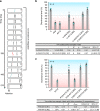Feature integration within discrete time windows
- PMID: 31653844
- PMCID: PMC6814726
- DOI: 10.1038/s41467-019-12919-7
Feature integration within discrete time windows
Abstract
Sensory information must be integrated over time to perceive, for example, motion and melodies. Here, to study temporal integration, we used the sequential metacontrast paradigm in which two expanding streams of lines are presented. When a line in one stream is offset observers perceive all other lines to be offset too, even though they are straight. When more lines are offset the offsets integrate mandatorily, i.e., observers cannot report the individual offsets. We show that mandatory integration lasts for up to 450 ms, depending on the observer. Importantly, integration occurs only when offsets are presented within a discrete window of time. Even stimuli that are in close spatio-temporal proximity do not integrate if they are in different windows. A window of integration starts with stimulus onset and integration in the next window has similar characteristics. We present a two-stage computational model based on discrete time windows that captures these effects.
Conflict of interest statement
The authors declare no competing interests.
Figures





References
-
- Breitmeyer, B. & Öğmen, H. Visual Masking: Time Slices Through Conscious and Unconscious Vision - Bruno Breitmeyer, Haluk Ogmen, Haluk Öğmen - Google Books. (Oxford University Press, 2006).
-
- Taylor MM, Creelman CD. J. Acoust. Soc. Am. 1967. PEST: Efficient Estimates on Probability Functions; pp. 782–787.
Publication types
MeSH terms
LinkOut - more resources
Full Text Sources
Other Literature Sources

